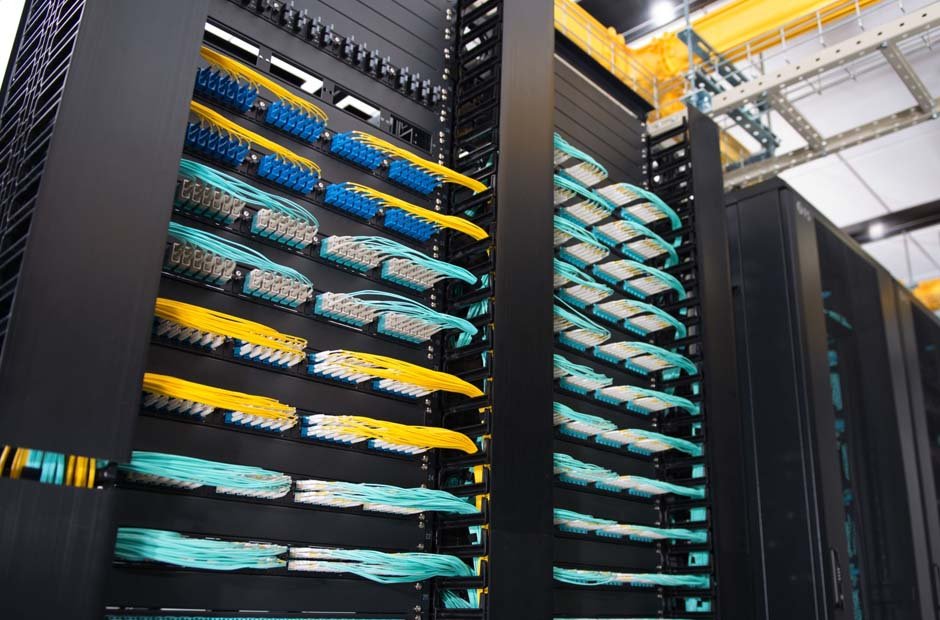Cabling infrastructures are the backbone of communication networks in the business world.
This infrastructure refers to the physical network of cables, connectors, and related components for the transmission of data, voice, and video signals between devices and equipment within an organization. It provides connectivity for computers, servers, switches, routers, telephones, and other network devices.
In this post, we are covering two approaches within cabling infrastructures:
- Structured cabling
- Point-to-point cabling
Every business has different cabling requirements, and one solution might be more ideal than the other. But in most scenarios, structured cabling is the better option.
As a cabling company specializing in commercial technology solutions, we want to provide some guidance on this decision.
Let’s get going.
What is Structured Cabling?
Structured cabling is a standard approach to designing, installing, and managing the network infrastructure of a business. This approach involves an organized arrangement of cables, connectors, and related hardware to provide a reliable foundation for communication.
Components of Structured Cabling Systems
Structured cabling systems are made up of components that create an organized network infrastructure. The major components of structured cabling systems include:
- Cables
- Patch Panels
- Connectors
- Patch Cables
- Racks and Cabinets
- Cable Management
- Backbone Cabling
- Outlets and Faceplates
Advantages of Structure Cabling
There are many benefits to structured cabling, including:
- Centralized distribution: Uses a centralized point, such as a patch panel or main distribution frame (MDF), for connecting devices and equipment.
- Modular design: Allows for easy moves, adds, and changes (MACs) by providing flexibility to modify or expand the cabling system without disrupting the entire network.
- Support for multiple media types: Accommodates different types of cabling media, including twisted-pair copper cables and fiber optic cables to support various data applications.
- Labeling and documentation: Provides clear labeling and documentation of cable connections, making it easier to identify, trace, and troubleshoot network issues.
- Scalability and future-proofing: Allows for easy integration of new technologies and services, facilitating future network expansions and upgrades.
- Simplified management: Provides an organized and structured infrastructure, making it easier to manage and maintain the cabling system.
Standards for Structured Cabling
Before installing structured cabling, you need to be aware of the industry-recognized guidelines for designing, implementing, and managing these systems.
TIA/EIA-568:
TIA/EIA-568 standard provides specifications for commercial building telecommunications structured cabling service providercabling – defining the requirements for categories of twisted-pair copper cables (e.g., Category 5e, Category 6, Category 6A) and fiber optic cables, as well as the performance parameters, cable types, and transmission distances for various network applications.
ISO/IEC 11801
ISO/IEC 11801 is an international standard for generic cabling for customer premises. It provides guidelines for the design and installation of structured cabling systems, covering both copper and fiber optic cabling. The standard specifies performance levels, transmission characteristics, and test methods to ensure reliable data transmission.
Fortunately, you don’t have to learn these guidelines backward and forwards. When you work with a professional , they will manage all of this for you and make sure everything follows the industry’s guidelines.
What is Traditional Point-to-Point Cabling?
Point-to-point cabling is a direct connection approach to a cabling infrastructure in which individual cables are used to establish a direct link between two network devices or endpoints. Each device is connected to its corresponding counterpart through a dedicated cable.
Limitations of Point-to-Point Cabling
Higher cost: As a business grows and adds more devices, the cost of point-to-point cabling rises due to the need for additional cables, connectors, and labor. The individualized nature of the cabling approach can result in higher installation and maintenance expenses compared to more organized alternatives like structured cabling.
Scalability challenges: Scaling a point-to-point cabling infrastructure can be tough, as adding more devices requires individual cables to be installed and connected to each new endpoint. This can lead to a complex and cluttered cabling setup as the number of devices increases.
Limited manageability: Managing and troubleshooting a point-to-point cabling system can be more time-consuming and cumbersome compared to structured cabling – as identifying and tracing cable connections gets more complicated with more devices.
Increased maintenance and troubleshooting: The direct and individual connections make it harder to trace and diagnose problems, leading to longer troubleshooting times and potential network downtime.
Point-to-point cabling is more suitable for smaller deployments or when a direct connection is necessary. But it may become impractical for larger networks due to its scalability and manageability limitations.
Considerations and Best Practices for Structured Cabling Implementation
The most important thing you can do with structured cabling is to hire professionals to get the job done right – the first time. Designing, implementing, and maintaining a cabling infrastructure without proper knowledge can result in serious (and expensive) headaches down the road.
When you hire a professional, you’re getting all the necessary knowledge, skills, and experience to ensure you have a reliable structured cabling system – in a timely manner that doesn’t disrupt daily operations.
Moreover, they are familiar with industry standards, best practices, and the latest technologies, allowing them to create a high-performing and efficient cabling infrastructure.
The Wrap
Structured cabling has many advantages over point-to-point cabling. This is largely due to the standardized and organized approach.
With structured cabling, you get a centralized and hierarchical system, allowing for more scalability, flexibility, and easier management. Overall, this approach provides better performance and reliability – while also offering cost savings in the long run through lower maintenance and operational expenses.
Hopefully, this post has guided you in the right direction. For any other questions about structured cabling, reach out to a professional in your area.


